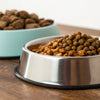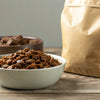Mastering the Transition: How to Switch from Wet to Dry Dog Food
- Houndsy
Table of Contents
- Introduction
- Understanding Your Dog’s Dietary Needs
- Steps for Switching from Wet to Dry Dog Food
- Troubleshooting Common Issues
- The Benefits of Dry Dog Food
- Integrating the Houndsy Kibble Dispenser
- Conclusion
Introduction
Did you know that approximately 40% of dog owners switch their pets’ food at least once a year? Whether due to changing nutritional needs, the desire for variety, or dietary recommendations, transitioning your furry friend from wet to dry dog food can be a common yet daunting task. As loving pet parents, we want to ensure that our dogs are happy, healthy, and well-nourished, which makes understanding how to navigate this change essential.
In this blog post, we will guide you through the process of switching your dog from wet to dry food, demystifying the steps involved and the best practices for a smooth transition. By the end of this article, you will understand the reasons behind a food switch, how to execute it effectively, and the benefits you and your dog can enjoy from the change. We’ll also highlight how our innovative Houndsy Kibble Dispenser can enhance your dog-feeding experience, making portion control and convenience a breeze.
Why Switch from Wet to Dry Dog Food?
Switching from wet to dry dog food can stem from various reasons. Here are some common motivators:
- Cost-Effectiveness: Dry food is often less expensive than wet food, which can be a crucial factor for many pet owners.
- Dental Health: The texture of dry kibble helps scrape plaque off your dog’s teeth, promoting better dental hygiene.
- Convenience: Dry food is easier to store and measure, making feeding time simpler and cleaner.
- Longer Shelf Life: Dry dog food typically has a longer shelf life than wet food, reducing waste and spoilage.
As we navigate this transition together, it’s important to reflect on your dog’s specific needs and preferences. Each dog is unique, and understanding their dietary requirements is essential for ensuring their health and happiness.
Understanding Your Dog’s Dietary Needs
Before making any changes to your dog’s diet, it’s crucial to understand their nutritional requirements. Factors such as age, breed, weight, and health conditions can significantly influence what food is best for your dog.
Age and Life Stage
- Puppies: Growing puppies require higher protein and fat content for their development. If you’re transitioning a puppy from wet to dry food, ensure that the dry kibble is specifically formulated for puppies.
- Adults: Adult dogs need a balanced diet that maintains their energy levels and overall health. Choose a high-quality dry food that meets these needs.
- Seniors: Older dogs may have different dietary requirements, including lower calories and specialized nutrients for joint health. Look for senior formulas that cater to these needs.
Breed-Specific Needs
Different breeds can have unique dietary needs. For instance:
- Large Breeds: Require larger kibble sizes that support their joint health.
- Small Breeds: Benefit from smaller kibble that is easier for them to chew.
Health Considerations
If your dog has specific health concerns such as allergies, obesity, or digestive issues, consult your veterinarian before switching foods. They can recommend the best dry food options tailored to your dog’s unique health profile.
Steps for Switching from Wet to Dry Dog Food
Transitioning your dog’s diet should be done gradually to prevent gastrointestinal upset. Here’s a step-by-step approach to ensure a smooth switch:
1. Start Slow
Begin by mixing a small amount of dry food with the wet food your dog is currently eating. A recommended starting ratio is 75% wet food to 25% dry food. Over the course of a week, gradually increase the proportion of dry food while decreasing the wet food.
2. Monitor Your Dog’s Response
Keep an eye on your dog’s behavior and health throughout the transition. Look for signs of discomfort such as vomiting, diarrhea, or refusal to eat. If your dog shows any adverse reactions, slow down the transition process.
3. Use a Transition Schedule
A structured schedule can help facilitate the switch. Here’s a suggested transition plan over a week:
- Day 1-2: 75% old food (wet) / 25% new food (dry)
- Day 3-4: 50% old food / 50% new food
- Day 5-6: 25% old food / 75% new food
- Day 7: 100% new food
4. Enhance the Dry Food
To make the transition more appealing, consider adding some enticing flavors or textures to the dry kibble. You can mix in a bit of low-sodium broth, warm water, or even some wet food to enhance aroma and taste. This can make the dry food more inviting for your pup.
5. Establish a Routine
Once your dog is fully transitioned to dry food, establish a consistent feeding schedule. This helps your dog understand when to expect meals and may improve their appetite.
Troubleshooting Common Issues
Transitioning your dog from wet to dry food may present challenges. Here are some common issues and solutions:
1. Refusal to Eat
If your dog refuses to eat the new dry food, try:
- Mixing in a small amount of wet food or broth to enhance flavor.
- Offering the food at room temperature rather than cold, as warming can release tempting aromas.
2. Gastrointestinal Upset
If your dog experiences diarrhea or vomiting during the transition:
- Return to the previous food and slow down the transition process.
- Keep your veterinarian informed of any ongoing issues.
3. Behavioral Changes
Some dogs may exhibit behavioral changes, such as increased anxiety around feeding times. Ensure that feeding remains a stress-free experience by minimizing distractions and providing a calm environment.
The Benefits of Dry Dog Food
Once your dog is fully transitioned to dry food, you may notice several benefits:
- Improved Dental Health: The crunchy texture of dry kibble helps reduce plaque buildup on teeth.
- Easier Portion Control: Dry food allows for precise measurements, making it easier to manage your dog’s caloric intake.
- Less Mess: Dry food is easier to clean up, reducing the chaos during feeding time.
Integrating the Houndsy Kibble Dispenser
At Houndsy, we understand the importance of making feeding time an enjoyable and efficient experience. That’s why we created the Houndsy Kibble Dispenser—a stylish and functional solution that elevates the dog-feeding ritual.
With a convenient crank at standing height, the Houndsy Kibble Dispenser eliminates the need for bending, making it easier for us to serve our dogs. It offers perfect portion control every time, ensuring that your furry friend receives the right amount of food without the hassle. Plus, with a large storage capacity of 25–30 lbs and a BPA-free liner for freshness, it’s the ideal companion for every dog owner.
Not only does our dispenser combine quality and design excellence, but it also complements modern home decor, allowing you to feed your dog while keeping your living space beautiful.
Ready to enhance your dog-feeding experience? Explore the Houndsy Kibble Dispenser here.
Conclusion
Switching your dog from wet to dry food can seem challenging, but with a structured approach and an understanding of your dog’s needs, it can be a seamless transition. By following the outlined steps and being mindful of your dog’s reactions, you can ensure their diet change is successful and beneficial.
As we navigate the world of pet care, we want to emphasize the importance of quality, convenience, and design in our feeding practices. The Houndsy Kibble Dispenser embodies these values, making feeding time an enjoyable experience for both you and your furry friend.
Are you ready to make this transition? Consider your dog’s unique needs, and remember that we’re here to support you in enhancing your pet's feeding experience.
FAQ
1. How long should I take to switch my dog from wet to dry food?
It’s generally recommended to take about a week for a complete transition, gradually decreasing the amount of wet food while increasing the dry food.
2. What if my dog doesn’t like the dry food?
Consider mixing in a small amount of wet food or broth to enhance flavor. If your dog still refuses to eat, you may need to try a different brand or flavor of dry food.
3. Can I mix wet and dry food?
Yes! Mixing wet and dry food can make the meal more appealing to some dogs and can aid in the transition process.
4. What should I do if my dog experiences gastrointestinal upset?
If your dog shows signs of diarrhea or vomiting during the transition, revert to the old food and consult your veterinarian if symptoms persist.
5. How can I ensure my dog is getting the right nutrition with dry food?
Always choose a high-quality dry food that meets AAFCO standards for complete and balanced nutrition. Consider your dog’s specific needs and consult your veterinarian for recommendations.
If you're interested in simplifying your dog-feeding routine, explore the Houndsy Kibble Dispenser today! Order Now.












